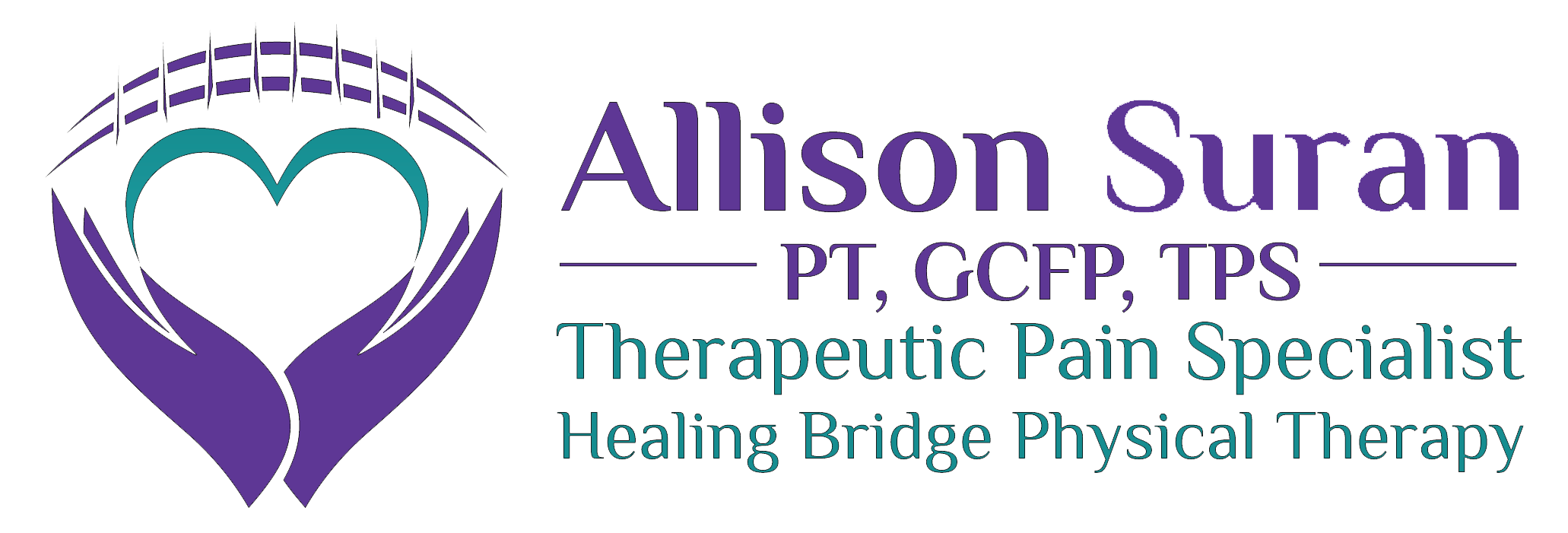The Feldenkrais Method®
Awareness Through Movement® Lessons
With Allison Suran, PT, GCFP, TPS
Intro and Preparation:
This introduction is to help you fully enjoy the Awareness Through Movement lessons.
Awareness through Movement lessons are usually gentle movements done lying on the floor. Occasionally movement lessons are done in sitting or standing as well. The purpose of lying on the floor is for you to more fully feel the connections of movements throughout your body, however if getting up and down from the floor is difficult, or lying on the floor is just too painful, lying on your bed may be the best option.
The movements you are about to perform are designed for people of all kinds. I tend to teach lessons for people experiencing chronic pain, so most of the lessons have gentle and simple movements. There are more advanced lessons for people who are not experiencing pain and are looking for improvements in other areas of their life, like physical or musical performance, or just everyday well-being.
The first thing many people notice about the lessons is how slow they are. Awareness Through Movement lessons are not just designed to make your body feel better – they are designed to teach your mind to learn to focus on the integrated support of your whole body. They help you feel the connectivity of your skeleton and how it provides support for your muscles so that they can relax from habitual holding patterns that may be contributing to strain and pain, or responding to stress. They can teach you how to focus your mind on what is working well and providing support in your body rather than just always noticing what is hurting. As you develop the capacity to intentionally focus your mind, you can discover for yourself how to experience greater freedom of movement, relaxation, decreased pain, and a new way of using your body to interact in many aspects of your life.
Two things may happen when you initially engage in slow, intentional movements. You may think, “This is boring”. This is just the mind resisting the quietness, as it is not used to such intentional focus. It also may feel that this is not “productive” and that you should be “doing something”. Try to just notice those thoughts and then re-focus your attention on the movements. I often describe these movement lessons as movement-meditation, or brain exercise. Our brains and minds our often not use to becoming quiet for internal focus. This improves over time and is extraordinarily valuable.
The other thing that often occurs is that people fall asleep. Again, this is due to the lack of discipline we have in intentionally focusing our mind. Of course, you may just be tired as most of us push ourselves to exhaustion. Also, if you are experiencing pain, it may be interfering with your sleep patterns causing fatigue. However, the primary reason for falling asleep during a lesson, is that most minds are fairly undisciplined. We think thousands of thoughts throughout the day, and most of them are the same repetitive thoughts we thought yesterday and the day before that, and so on. Many people have also learned to focus externally on the many tasks one needs to do to get through the day. Learning to focus your mind on the current sensations in your body is a powerful tool that can enhance many areas of your life.
There are a few simple guidelines I like to suggest:
Never do anything that hurts or hurts more. Since most of my clients are already experiencing pain, the purpose of these movements is to discover that there are movements that do not need to hurt. Do not push yourself. If I give an instruction that is uncomfortable or increasing the pain somewhere in your body, do less, or just imagine it. Feel free to adjust your position so that you can be of most comfort. We want to decrease the distraction of pain, so that you can learn to focus on other aspects of your body.
2. Less is More: This follows the first instruction. Do the movements slower and smaller…slower and smaller. This will increase the capacity of your minds ability to focus, and decrease the tendency to use old familiar ways of moving so that you can discover new, pain-free ways of experiencing movement.
3. There is no right or wrong way to do a lesson. These are experiments in movement. Opportunities for discovery. I invite you to redevelop the curiosity in you that you had as a child. When you were young, you didn’t worry about drawing within the lines, you just played and had fun. Be easy with yourself and just do what you think is right, with little worry about what anyone else might think.
4. Try to do at least 3 lessons per week if you really want to notice improvements. We are changing patterns of a lifetime, be gentle but consistent with yourself. Try to notice and identify the sensations you feel after a lesson, write down a few words that describe these sensations, and remember to look for them throughout each day.
5. Enjoy yourself. Notice the tendency of the mind to judge – it’s OK, it’s been practicing this for years. Try to just acknowledge the “judge” and then gently, playfully, turn your attention back to sensations that are of interest.
There is much more that could be said, but I encourage you to hang out for the experience. Enjoy, and may your new sense of your self emerge in new and wonderful ways throughout your life.
Allison
